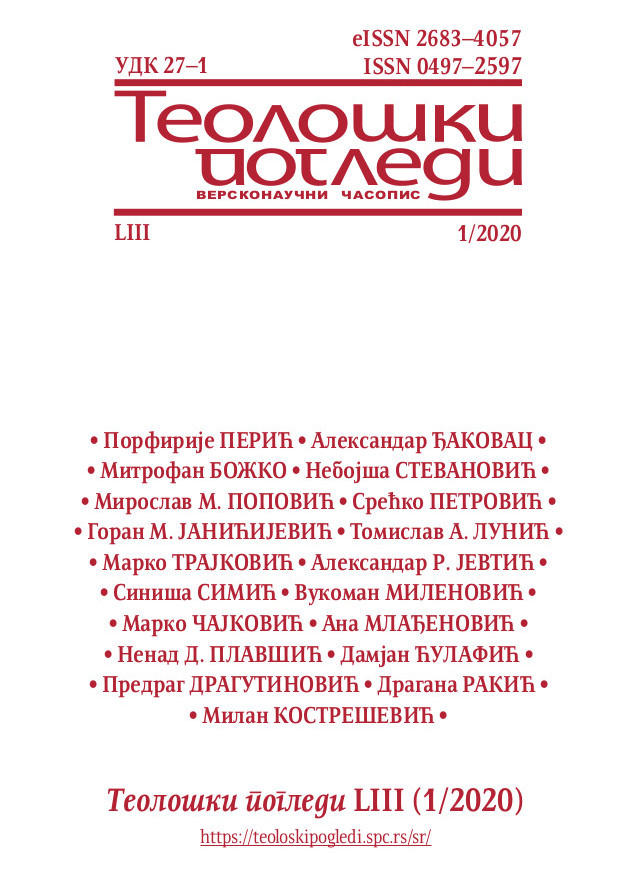Прилог Проучавању српско-руских црквених односа
A Contribution to the Research of Serbian-Russian Church Relations
The Connection of the Serbian Hierarchy with the Orthodox Church Mission in India during the 1930’s, With Special Reference to the Plausible Role of Bishop Nicholai Velimirović
Author(s): Srećko PetrovićSubject(s): Local History / Microhistory, Eastern Orthodoxy, History of Religion
Published by: Свети Архијерејски Синод
Keywords: Nicholai Velimirović; Dositej Vasić; Andronik Elpidinski; Nestor Anisimov; Dimitry Voznesensky; Anastasius Gribanovsky; Gevargeze II; Serbian Orthodox Church; Russian Orthodox Church Outside Russia
Summary/Abstract: Missionary activity in India during the 1930’s connected the hierarchs of the Russian Orthodox Church Outside Russia and the Serbian Orthodox Church with the Indian Oriental Orthodox Christians, namely with the hierarchs and the clergy of the Malankara Orthodox Church. Hieromonk Andronik Elpidinski went to India in 1931, and there he met with Malankara Orthodox Catholicos Gevargeze II and other Malankara Orthodox personnel. He established warm and close connections with Indian Orthodoxy. According to the writing of Archbishop Nestor (Anisimov) of the time, Elpidinski chose to join Indian Orthodox missionaries instead of proselytizing and establishing a new parish. On the other hand, Catholicos Gevargeze II established connections with Russian Orthodox hierarchs. He met Archbishop Anastasius (Gribanovsky) in Jerusalem in 1934, and afterwards he sent the official letter to the Synod of the Russian Orthodox Church Outside Russia and asked them if Malankara Orthodox Church could be united with the Orthodox Church. Bishop Dimitry (Voznesensky) visited India in 1936 in order to investigate the possibilities of unity. Serbian Orthodox Church supported this initiative. Bishop Dositej (Vasić) was in India in 1937, where he attended World’s Conference of YMCAs in Mysore. In India he also met Gevargeze II, and invited him to visit Serbian Orthodox Church. Going back home from The World Conference on Faith and Order in Edinburgh, Gevargeze II arrived to Belgrade in September 1937. He spent about 10 days in Yugoslavia. He was warmly welcomed and he was honoured as a Patriarch. In Yugoslavia he met several Russian and Serbian bishops, had meetings with them, including a long lasting meeting with Bishop Nicholai (Velimirović) of Žiča. He also visited ancient Serbian monasteries, including monastery of Žiča — the see of Bishop Nicholai. Archbishop Nestor went to India in 1938, in order to negotiate on future reunion of Indian Orthodox Christians with the Orthodox Church. But there were almost no results of this mission. As the consequence of the WWII outbreak, communication stopped very soon. However, the details about the organization of this mission are not well known, and the literature shows that there are questions that cannot be answered, as well as that sources for research are scarce. Nicholai Velimirović’s closeness and connections with the people who were involved in these missionary efforts, as well as his interest in the mission in general and India in particular, indicate that in a certain way he could be connected to these events. He was interested in India and in Christian mission in India, which is attested in his writings from 1910’s onwards. Besides testimonies from Velimirović’s writings, memories of participants and historical records suggest this assumption. He financially supported Elpidinski’s mission. He was a close friend of Archbishop Nestor. In Yugoslavia, he met Gevargeze II, and he had a long conversation with him regarding mission in India, as it was reported by newspapers. On the other hand, he was also connected with Archbishop Anastasius and Archbishop Dimitry as well, so there is a possibility that somehow he was involved in events regarding joint engagement of the Russian Orthodox Church Outside Russia and the Serbian Orthodox Church with the Indian mission in 1930’s. However, since there is no direct reference and we could not find а clear enough testimony, such a conclusion could not be made. In the present article, we will simply offer a short review of Serbian literature and sources, and also a review of references to India and mission to India in Bishop Nicholai’s writings, which maybe could be helpful for some future researchers.
Journal: Теолошки погледи
- Issue Year: LIII/2020
- Issue No: 1
- Page Range: 79-128
- Page Count: 50
- Language: Serbian

